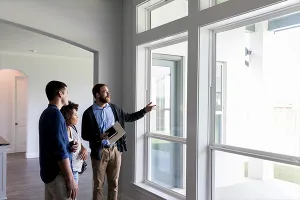In the course of researching this article, speaking with experts and local officials across the country about a housing crisis that cuts across every generation, I kept thinking over and over again, “Yep, I can relate.
A housing crisis is hitting across the country and across generations and race.
My wife and I are nearing retirement age and starting to think about selling the house where we raised three boys, passing it on to the next family as we relocate to something smaller and easier to maintain. Ideally, that would be a single-story condominium somewhere near our walkable Seattle neighborhood, but we’re not seeing anything like that being built (I’ve learned that onerous condo rules and expensive development codes are large reasons; more on that later).
Meanwhile, two of our 20-something sons are living with us (again). One has a decent job with a tech startup, but his salary doesn’t come close to covering local housing costs. The other is back in school and working and living in his parents’ home, currently the best of not-great housing options. At the other end of the spectrum, I recently buried my Mom, who at nearly 88 had been struggling to remain in her house as it became increasingly clear she could no longer do so without help. Had she lived, assisted living would have been the next logical step, but the costs were out of reach.
What I’ve learned in conversations with both national experts and local officials is that this story is not uncommon and that our experience of inter-generational housing angst is not a Seattle, West Coast or even a big-metro thing. It’s everywhere.
“From our standpoint as a national association, we are looking at a housing crisis that’s not regional, it’s hitting across the country and across generations and race,” said Drew Myers, policy representative for state and local issues for the NATIONAL ASSOCIATION OF REALTORS® (NAR). NAR’s Housing Affordability Index recently showed that the typical family can no longer afford to purchase the median-price home, he noted. “Since 2020 — in the length of time it took a recent graduate to go through college—the median-priced home has increased over $100,000 and recently settled about $70,000 above the median price in early 2020. That growth prices out well over 5 million households from purchasing that median-priced home.”
A well-documented lack of new construction of homes of all types since the 2008 real estate crash and continuing through the COVID slow-down has meant the supply of housing lags well behind demand. But from the perspective of home seekers at various life stages, the overall shortfall is exacerbated by artificial constraints on production of a range of housing types that could meet the needs and budgets of fresh-from-school workers, young families, recent retirees and older adults.
There are many factors behind the overall housing deficit, from supply chain issues to the cost and availability of labor to finance industry practices. But too often the inability to create more attainable small-lot homes, mid-rise apartments, accessory dwelling units, condominiums, duplexes and more comes down to local regulatory practices, said Lauren Lowery, director of housing and community development at the National League of Cities (NLC). “When you talk about affordability, availability, homelessness, it all goes back to supply, and that is very much shaped by the regulatory environment,” she added. “When it comes to ensuring housing for each stage of life, there needs to be an openness in local communities about the various types of housing that could be available.”
Producing a Playbook for Locally Driven Housing Solutions
To help local officials find solutions to their communities’ supply snags, the NLC recently joined with the American Planning Association (APA) to form the “Housing Supply Accelerator” campaign. That effort, notes the campaign website, “brings together local governments, community planners, builders, financial institutions, housing policy associations, real estate professionals, and state and federal partners to [promote] solutions for housing supply challenges at the local level.” This spring, that collaboration released the “Housing Accelerator Playbook,” a compendium of dozens of recommended actions for local communities, nearly all supported by a real-world example from a U.S. city, town, county or region.
Myers, who represented NAR as one of several industry partners guiding the NLC-APA Playbook effort said, “One solution the Playbook emphasizes that cuts across generations is missing middle housing. ‘Missing middle’ refers to the types of housing that fall between large-lot standalone houses and multistory apartment buildings, such as ‘granny flats’ and detached accessory dwelling units (ADUs); duplexes, triplexes and quad-plexes; cottage courts; townhomes; and four-story and courtyard apartments. In the last century, we have been zoned into large-lot, detached single-family homes in suburban neighborhoods. This has shaped our vision of the American dream. But the dream of homeownership can look different across generations. For many, walkable, mixed-use, missing middle housing is much more appealing. We see that among millennials who want to be close to a vibrant downtown and baby boomers who are looking to downsize their home but not their lifestyle.”
And there are a large and growing number of them, said Jenn Jones, vice president for government affairs at AARP. She pointed to a 2023 report, “Housing America’s Older Adults,” from Havard’s Joint Center for Housing Studies that noted that “the U.S. population 65 and over soared by 34 percent in the last decade, from 43 million in 2012 to 58 million in 2022.” Over the next 10 years, the authors project, those over 80 will be the fastest growing cohort. The report also notes that in 2021, “an all-time high of nearly 11.2 million older adults were cost burdened, meaning they spent more than 30 percent of their income on housing.”
According to AARP surveys, Jones said, 78 percent of aging homeowners prefer to stay where they are, “despite the fact that the housing type might not be as accommodating to their changing needs as it could be.” But whether they stay put or move, “Older adults want to live independently more than anything, So, they need access to transit and daily needs, places to get out and walk around.”
Jones lauded the Playbook for highlighting zoning and policy changes that would open up more opportunities for ADUs, create more single-story units in walkable areas with services, and specify accessibility features in new construction. “ADUs allow for multigenerational living, because the parents can live with a child’s family or a young adult child can get a start,” Jones said. “They also are another source of income for older adults who can use the revenue to stay in place.”
Promoting more age-friendly, well-located condominiums and apartments helps multiple generations as well. “People looking to downsize are not finding those units. Younger buyers looking for starter homes are finding that baby boomers are still living there and don’t intend to move.”
“The biggest question is how do you know you have a housing supply issue,” said Jennifer Raitt, executive director of the Northern Middlesex Council of Governments in Lowell, Mass., and also represents the American Planning Association on the Housing Supply Accelerator Steering Committee. “People don’t know that inherently, so some research is warranted.”
Some states—such as Washington and California—require localities to produce a housing needs assessment, but most localities are operating without one. Jurisdictions that have sufficient resources often hire a consultant to mine data sources and produce a report, but a DIY approach is also possible, Raitt said. “It’s a combination of looking at demographic data from the Census (age and income breakdowns) and matching it to the permits being issued and what they are for. You also want to look at development projects and how long they took, and who can afford them. You want to do an analysis of trends in the types and amount of housing production. You can do a survey or interviews of people who live in your community or people who would like to live in your community. It’s important to look at the cost burden: What share of their income do people have to spend to afford a place to live, and is that sustainable?”
Testing the Limits of Local Action in Clearfield City, Utah
Mark Shepherd, mayor of Clearfield City, Utah, considers it fundamental to his job to have a handle on the housing supply needs. Lying 20 miles north of Salt Lake City at the edge of Hill Air Force Base, the city of 36,000 people is growing rapidly thanks to the presence of defense contractors and recreational goods manufacturers. “We’ve done surveys through our community and developers to find out what we’re missing,” Shepherd said. “We haven’t done a formal study, but we know that the vast majority of need is for starter homes. We have so many people who can’t afford a house, whether coming out of college, or seniors who would love to downsize,” Shepherd said. “And they say it’s just not available. We are trying to do everything we can to allow for increased supply and drive down prices.”

Even as younger workers arrive looking for a place to live, Clearfield has a large and growing elder population. “I get more calls for senior housing than for anything else, both for sale and for rent,” said the mayor. “A lot of them are totally fine renting, as long as it is a senior development and age restricted. Seniors also prefer underground parking or wrap-around parking [on the same level as living], which is more expensive to build. However, finding a developer to do that is harder, because of expense and they don’t want to restrict their market. Lenders are leery of financing a seniors-only project, even though they can get higher rental rates.”
Clearfield has cleared the way for many more ADUs, both within and detached from stand-alone houses, the mayor said. “I’ve seen more multi-generational living than I ever thought I would. Most of the ADUs are kids getting a place or mom and dad moving into an ADU to live closer to the kids.”
Allowing for more duplexes and other missing middle has helped to address other intergenerational needs, he added. “We’ve had parents and kids building adjoined two-family homes. They’ll have three generations of family living in that house. They live near parents and grandkids, but they have doors that they can close and get separation.”
While reforming zoning and development codes to promote more housing of varying types has helped grow supply, prices remain stubbornly high, he said. “With builders, when I ask them if we reduce impact fees, parking requirements, etc., will they pass that on to buyers and renters and they say, ‘No.’ We’ve gone to smaller lots, reduced parking requirements and it has not changed our housing prices. I’d love to have the confidence to say that if we waive fees or reduce requirements it would reduce the price, but demand is so high that the prices don’t come down.”
Tempe Works to Create More Affordable Rental and Homeownership Opportunities
Tempe, Ariz., Mayor Corey Woods shares Shepherd’s concerns over recalcitrant housing prices. As the city is home to Arizona State University and close to Phoenix, “housing is critically important in the city of Tempe,” he said. “More and more people are coming to Tempe and Maricopa County than ever before. We need housing of all kinds—affordable, market, for sale and for rent, workforce.”

To prompt developers to help meet that wide range of need, Tempe has opened up the rulebook. In March, voters approved a new 10-year general plan that allows for more density and “codifies the need for a diversity of housing stock” by a resounding 60 percent. “We very intentionally disclosed to our voters that planners estimate we’re going to get another 70,000 residents by 2050, and we already don’t have enough housing,” he said. Also critical to Tempe’s affordability and meeting the needs of its senior and student population, the plan calls for significant upgrades for walking, transit and bicycle transportation as well, so that owning and operating cars is less of a requirement.
But like Clearfield’s mayor, Woods recognizes that all the building in the world won’t address the deep affordability gap for hourly wage workers, seniors on fixed incomes and low-income families. “We need more affordable rentals and ownership opportunities,” Woods said. “The market-rate stuff builds itself, because the companies that build it have the financial backing and the know-how. Land values are so high these days that it’s very hard for affordable home developers.”
His administration launched a program called “Hometown for All” that directs half of development fees to support affordable and workforce housing. Those funds are directed to city-affiliated nonprofit, Tempe Coalition for Affordable Housing, which pairs them with other public- and private-funding sources to acquire houses, apartments and condos that are kept permanently affordable. The program also purchases land for affordable housing and supports redevelopment of city-owned properties. “You aren’t going to find vacant land sitting around, and if you did, it would be too expensive for affordable housing,” Woods said. “So, we have started to work on land banking. Then we can put out a [request for proposals] to partner with affordable housing developers.”
In addition, voters this fall are considering a $32-million-bond measure to provide further support for affordable housing. “If we leave it to the market, everything will be market rate. We need to take the profit motive out of it and make sure all our people can have a place to live.”
City of Spokane, WA, Addresses Housing Supply Obstacles
In 2022, after a New York Times story tagged Spokane as the “next affordable city that is already too expensive,” the city’s mayor declared a housing emergency and vowed to work with the city council to do something. But what? That’s when the Spokane Association of REALTORS® (SAR) matched a Housing Opportunity Grant from the REALTOR® Party to commission an in-depth report from the Counselors of Real Estate (CRE). “The study took place over 6 months, with 40-plus interviews,” said Darin Watkins, government affairs director for SAR. “Then they looked at other markets and what they’ve done. Of the 19 recommendations, I think we have implemented 15 of them.”
The city suspended single-family zoning restrictions citywide and made it legal to build duplexes, fourplexes and townhomes in any residential area while reducing parking mandates. In addition, said Spokane’s planning director, Spencer Gardner, “We’ve introduced new platting options that don’t require street frontage and give more flexibility on arrangement on the lot. You also can create fee simple lots to sell off.”
Not quite two years in, Gardner sees both the promise and limits of planning zoning reforms. “It’s early in construction terms that we’ve had the new rules in place. What we’re seeing so far is very encouraging,” he said. “We’re seeing a greater diversity of housing types which is exactly what we wanted. We’re seeing where people are finding extra space on large lots and putting in, say, townhomes. Those have turned out to be really popular. They can work for people looking to downsize and are more affordable for younger families.”
But Gardner acknowledges that the quantity and range are not what they could be, and not what they need to be to address a shortfall that cuts across generations. “We definitely think about housing in terms of life stage,” Gardner said. Under state requirements, Spokane produces a report on how its development regulations align with needs at various income levels. “That’s a proxy for housing types and for various life stages. We can show that our zoning allows for housing that meets income-level requirements, but of course we don’t actually develop it. Unfortunately, the changes we have made on their own don’t address supply. There are a lot of opportunities for infill across the city, and those are coming into play. But the scale of supply is not met simply by opening up opportunities in existing areas.”
While the numerous new townhomes provide more attainable options for moderate-scale homebuyers and some down-sizers, their prices are still high for all but upper incomes. And, their stairs make them a no-go for older adults and others with mobility concerns. Those needs could be better met in multistory buildings with single-story apartments, or stacked flats, whether rental or for-sale condominiums. But a combination of development codes and state regulations make that a tough niche to fill, Gardner said. “I think reforming our state condo law is probably the top affordability issue for buyers. They are inherently more affordable, but we make them nearly impossible to build.”
Likewise, stacked flats are currently hard to make pencil out given building and development codes. “We are peeling layers of the onion, and as we’ve peeled back zoning, we are realizing that our development codes are a big obstacle. They exist for good reason but can present problems. The reason townhomes are popular with developers is that you can build multiple together without the code requirements you get from stacked flat or apartment building. If I wanted to do a fourplex stacked flat, I’d have to do sprinklers, because as soon as you stack units vertically, other requirements come into play. They can be a huge expense.”
We need more affordable rentals and ownership opportunities.
Spokane’s next move is to try to address the design and development standards that present an ongoing obstacle. “We’re learning a lot about how the rules are impacting different designs and product types,” Gardner said. “We’re getting started on modifications to the rules to address design standards. One of the core tenets of the housing updates we did was flexibility, but we also added design requirements to alleviate concerns about mismatched or out-of-scale housing in pre-existing neighborhoods. In some cases, the standards aren’t clear enough, and in some cases what we’ve asked still creates some challenges, and we need to work on clearing those up where we can.”
A Vermont Nonprofit Adds Affordable Housing Without Building
Older adults who are aging in place often find themselves with more space but less assistance than they could use. At the same, there are always people looking for stable housing they can afford, and that’s as true in Vermont as anywhere. Enter HomeShare Vermont, a nonprofit agency that matches older adults living alone with housemates looking for an affordable place to live. Operating in eight of Vermont’s 14 counties, HomeShare plays matchmaker by vetting all potential roommates carefully. “We do six different background checks and four reference checks,” said Connor Timmons, HomeShare’s executive director. “We’re very, very picky.” Typical matches have included visiting nurses, new teachers, and recently divorced people in changed economic circumstances.

The 275 existing successful matches are the equivalent of “millions of dollars” worth of new, subsidized housing, Timmons noted. “And in a rural state where apartment buildings often meet opposition, even funded projects are tough to actually build.”
Vermont has an aging population, but at the same time is losing senior-living facilities. Ten have closed in just the last two years, he added. “We are heading in the wrong direction. When you think about someone who is maybe in their late 70s, early 80s, reaching the spot where living home alone feels less safe and comfortable, they are either looking at very expensive assisted living or moving in with a relative if that is even an option. Or they’re taking the risk of continuing to go it alone. Housing specifically geared toward seniors is usually a 3 to 5 year waiting list. That doesn’t work if you’re concerned about falls or otherwise challenged to keep living alone.”

Many of the hosts simply would like the presence of another person should they need help, while others get assistance with errands and appointments, house and yard chores or the like. One host wanted someone who would take over his chopping up contribution to the “wood bank” that helps low-income neighbors heat their homes, Timmons recalled. “It allows people to age in place in a more fulsome, exciting, and dignified way. It gives them more agency,” he said. “You can stay in a home you love and get extra support without feeling like you’re burdening a child or other relative.
“A lot of people come to us just looking for overnight presence but end up with a buddy who they can go out and do things with. It meshes the need for affordable housing and the need of seniors for personal and economic support.”
Federal Action Plays a Role in Boosting Housing Supply
Many seniors are aging in place out of a genuine preference, but in some expensive markets people don’t sell their homes because they fear the capital gains tax hit to the appreciation on their most significant asset, said NAR’s Myers. To ease that worry, NAR is supporting legislation in Congress dubbed the “More Homes on the Market Act.” Myers said, “The Act would provide some relief to sellers in the form of an increased tax exclusion. This would help the older generation looking to downsize and would make it easier for them to make that decision,” thereby opening opportunities for move-up and first-time homebuyers.
Also in Congress, NAR is supporting the “Revitalizing Downtowns and Main Streets Act,” which looks to incentivize the conversion of outmoded commercial space to housing. “Not every commercial building is right for residential development,” Myers said. “But in our current situation, there are a lot of underused commercial buildings, and it would be good to turn some of them into apartments or missing middle housing. Commercial buildings tend to be in places that are or could become walkable neighborhoods.”
In May, the House Financial Services Committee unanimously approved the bipartisan “Yes In My Backyard (YIMBY) Act” to promote local action toward boosting housing supply. It would incentivize state and local governments to find solutions, be it zoning regulations to allow for ADUs or missing middle and multifamily housing. The Act also wouldn’t dictate what local jurisdictions and states have to do but would require them to report specific actions toward removing obstacles to housing creation, or lack thereof, if they are receiving Community Development Block Grant (CDBG) funds from the Department of Housing and Urban Development.
“It will take a concerted and consistent effort for many years to get us to a place where supply begins to catch up and we get out of this underbuilding gap. And it takes action from all levels of government,” said Myers. “We didn’t get in this situation, and won’t get out of it, overnight.”












